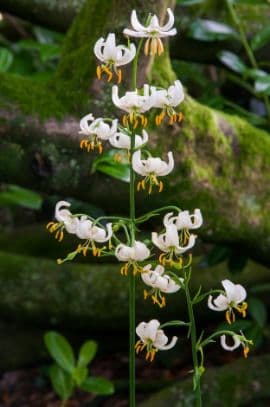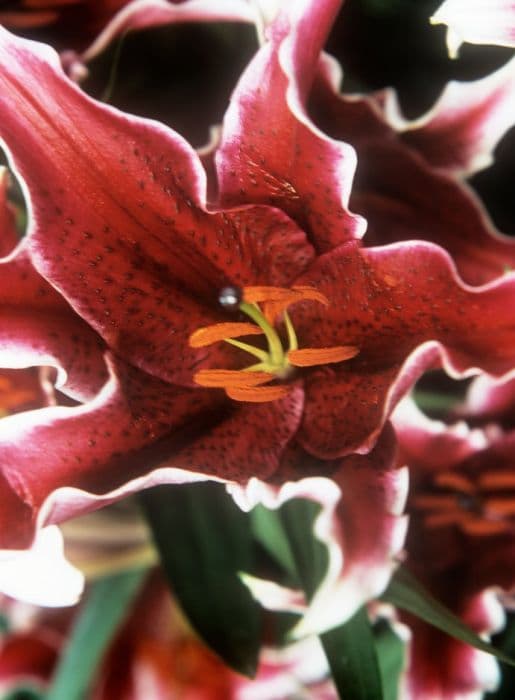Tulip Tulipa bifloriformis 'Starlight' (15)

ABOUT
The plant in discussion, commonly known as the tulip, showcases a striking and elegant form. The 'Starlight' variety is distinguished by its appealing flowers that possess a classic charm. Each flower is shaped like a star, which is where it is assumed to get the name 'Starlight'. The petals can be characterized by their vivid and contrasting colors, typically featuring a base color of white or cream with strokes or flames of a secondary hue such as pink or purple. Some blooms may appear more uniform in color, while others exhibit a multicolored pattern that is truly eye-catching. The plant's flowers have a smooth and waxy texture, which adds to their refined appearance. Inside the flower cup, there are often six stamens surrounding a central pistil, typical for this kind of species. The leaves are generally lance-shaped and have a green hue, which varies in intensity from deep to bright, providing a fresh backdrop that highlights the beauty of the blooms. The 'Starlight' tulip blooms in the spring, offering a seasonal show of color that heralds the warmer months. The way it carries its blossoms, on individual stems, gives it a proud and lofty appearance, with the flower heads tilting slightly as if reaching toward the sunlight. The plant's overall shape and how it holds its flowers above the foliage gives it an air of grace and charm, which makes it a beloved favorite for gardens and floral displays.
About this plant
 Names
NamesFamily
Liliaceae
Synonyms
Starlight Tulip
Common names
Tulipa bifloriformis 'Starlight'.
 Toxicity
ToxicityTo humans
This plant is a variety of Tulip, which are generally considered to be mildly toxic to humans if ingested. The toxic components are concentrated in the bulb more than the flowers or stems. If a person eats parts of a tulip, especially the bulb, they may experience symptoms such as nausea, vomiting, and diarrhea. In severe cases, ingestion can lead to dizziness, difficulty breathing, or an irregular heartbeat. It is important to avoid ingesting any part of tulips and to seek medical attention if ingested.
To pets
Tulips are also toxic to pets, including dogs and cats. Similar to their effects on humans, the primary toxic elements are concentrated in the bulbs. If a pet consumes parts of a tulip, they might exhibit symptoms like vomiting, diarrhea, drooling, or increased heart rate. In severe cases, ingesting tulip can lead to central nervous system depression, difficulty breathing, or even death. It is crucial to prevent pets from accessing tulips and to contact a veterinarian immediately if ingestion is suspected.
 Characteristics
CharacteristicsLife cycle
Perennials
Foliage type
Deciduous
Color of leaves
Green
Flower color
White
Height
1 foot (30 cm)
Spread
6 inches (15 cm)
Plant type
Bulb
Hardiness zones
3
Native area
Central Asia
Benefits
 General Benefits
General Benefits- Decorative Appeal: Starlight tulip is known for its beautiful and unique star-shaped flowers, which can enhance the visual appeal of gardens and landscapes.
- Spring Bloom: It offers a burst of color in early to mid-spring, marking the change of seasons and adding vibrancy to the garden after winter.
- Pollinator Attraction: These flowers are attractive to bees and other pollinators, helping to support local ecosystems.
- Ease of Cultivation: Starlight tulip is relatively easy to grow, making it a suitable choice for beginners and seasoned gardeners alike.
- Container Gardening: This plant is suitable for potting, which means it can be grown on patios, balconies, or indoors with adequate light.
- Durability: Starlight tulips are quite hardy and can withstand spring frosts, making them reliable bloomers in variable spring weather conditions.
- Cutting Garden: The flowers are excellent for cutting and creating vibrant spring bouquets that can bring the freshness of the garden indoors.
 Medical Properties
Medical PropertiesThis plant is not used for medical purposes.
 Air-purifying Qualities
Air-purifying QualitiesThis plant is not specifically known for air purifying qualities.
 Other Uses
Other Uses- Tulip petals can be used as a natural dye for fabrics, imparting a soft yellow or green color depending on the mordant used.
- The strong stems of tulips can provide support to weaker-stemmed plants when planted in close proximity in a garden.
- Dried tulip petals can be incorporated into homemade potpourri mixes for a subtle floral scent.
- Tulip bulbs can be carved into eco-friendly, biodegradable plant pots for starting small seedlings.
- The petals can be used as natural confetti for eco-friendly celebrations and weddings.
- Certain cultures use tulip petals as a garnish for salads and desserts, adding a colorful and edible element to dishes.
- The bulb's fibrous material can be used in the production of homemade paper, contributing to its texture and appearance.
- Tulip flowers are sometimes used in the craft of flower pounding to transfer their color and shape onto fabric or paper.
- The tulip's shape and vibrant colors can inspire artists and be used as models for botanical illustrations or paintings.
- The bulbs, when ground, can be added to compost as a nutrient-rich material to enhance soil quality.
Interesting Facts
 Feng Shui
Feng ShuiThe tulip is not used in Feng Shui practice.
 Zodiac Sign Compitability
Zodiac Sign CompitabilityThe tulip is not used in astrology practice.
 Plant Symbolism
Plant Symbolism- Perfect Love: The classic tulip, generally, symbolizes perfect love in flower language, thanks to its regal stance and bold colors.
- Eternal Love: Tulipa 'Starlight' shares the symbolism of eternal love with its perennial nature, reflecting a love that can survive hardships.
- Rebirth: As a spring-flowering bulb, tulips often represent rebirth and new beginnings, perfectly timed with the start of a new season.
- Charity: The 'Starlight' variety, with its star-like shape, could be seen to symbolize a shining light and hope, akin to charitable acts.
- Royalty: The tulip can also signify royalty due to its majestic presence and the historical tulip mania where it was valued by kings and queens.
- Fame: In certain cultures, tulips are associated with fame and being a perfect lover, as they stand out with their distinctive shape and vibrant colors.
 Water
WaterTulip 'Starlight' requires moderate watering, relying on soil moisture levels rather than a fixed schedule. Generally, you should water once a week with about half a gallon per plant during the growing season, ensuring the soil is moist but not waterlogged. Adjust the watering frequency according to weather conditions, watering more often during dry spells and less during rainy periods. Overwintering bulbs typically do not need additional watering unless the climate is exceptionally dry. It is crucial to avoid over-watering, which can lead to bulb rot.
 Light
LightThe Tulip 'Starlight' thrives in full sun to partial shade conditions. Ideally, the plant should receive at least 6 hours of direct sunlight daily. Planting in a spot that benefits from morning sunlight and afternoon shade can help protect the flowers from intense midday sun, especially in hotter climates. However, too much shade will result in poor blooming, so choose a location where the plant will get ample light.
 Temperature
TemperatureTulip 'Starlight' prefers a temperate climate with cool to moderate temperatures. It can tolerate winter lows down to 20°F and is comfortable in spring temperatures that do not exceed 70°F. The ideal temperature range for this tulip falls between 50°F and 65°F during its active growth period. Ensuring that the plant is not exposed to prolonged periods of heat above 75°F is important to prevent stress and to promote healthy growth.
 Pruning
PruningPruning Tulip 'Starlight' is not required for the health of the plant but removing spent flowers, a process known as deadheading, can prevent seed formation and encourage the plant to store energy in the bulb for next year's growth. The best time to prune or deadhead is when the flowers start to fade and before seeds begin to form. Do not remove foliage until it has completely died back naturally as the leaves provide necessary nutrients to the bulb.
 Cleaning
CleaningAs needed
 Soil
SoilThe Starlight tulip thrives in well-draining, fertile soil with a slightly acidic to neutral pH of 6.0 to 7.0. The ideal soil mix would include equal parts of loamy soil, compost, and sharp sand to improve drainage.
 Repotting
RepottingStarlight tulips are typically not repotted as they are grown from bulbs; instead, they are planted annually in the fall before the ground freezes.
 Humidity & Misting
Humidity & MistingStarlight tulips prefer average humidity levels and do not require any special humidity considerations.
 Suitable locations
Suitable locationsIndoor
Place in bright, indirect light and cool temperatures.
Outdoor
Plant bulbs in fall, in well-draining soil, full sun.
Hardiness zone
3-8 USDA
 Life cycle
Life cycleTulipa bifloriformis 'Starlight', commonly referred to as the Starlight Tulip, begins its life cycle as a bulb planted in the fall, containing the embryonic plant and food reserves. With the arrival of spring, the bulb breaks dormancy, and shoots emerge from the soil, quickly developing into distinctive lance-shaped leaves and a flowering stalk. The plant then produces one or two star-shaped flowers with the characteristic coloration, usually blossoming from early to mid-spring. After pollination by insects, the flowers fade, and the plant sets seed, which can be dispersed to produce new plants. Throughout the summer, the above-ground plant parts die back, and the tulip enters a period of dormancy, surviving underground as a bulb. This annual cycle repeats each year, with the bulb regenerating and ensuring the propagation and survival of the Starlight Tulip.
 Propogation
PropogationPropogation time
Spring
Tulipa bifloriformis 'Starlight', commonly known as Tulip 'Starlight', is typically propagated by bulb division. This popular method involves carefully lifting the mother bulbs from the ground after the foliage has died back, which usually occurs in late summer to autumn. Once lifted, the offsets, which are smaller bulbs that have formed around the base of the mother bulb, are gently separated and can be replanted immediately. Each offset will potentially grow into a new plant the following season. It's crucial to plant the bulbs at a depth that is three times their height, and at least 4 to 6 inches apart to allow room for root growth. The ideal time for replanting is in the fall, and this gives the offsets a chance to establish roots before the winter.







![Lily [Roselily Chelsea]](/_next/image?url=https%3A%2F%2Fplants-admin.emdemapps.com%2Fimages%2Fplants%2F%2Fimages%2F604b584f6f830.png&w=640&q=75)

